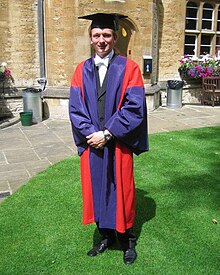Doctor en Filosofía
o DPhil) es un diploma de doctorado especializado en investigación en áreas tan diversas como las ciencias sociales y económicas; áreas científicas, médicas o de las humanidades.
Debido a la influencia anglosajona, el apelativo PhD y similares suele utilizarse generalmente.
El término Filosofía (philosophy) se utiliza con la misma frecuencia con la que se empleaba y difundía antes del siglo XX en las universidades alemanas y designa el estudio general de conocimientos y el amor por los mismos, según reza la etimología de la palabra.
Esta denominación rápidamente se difundió en el espacio germano y nórdico, como una diferenciación de los doctorados conferidos a investigadores de mayor edad ya ampliamente reconocidos por sus méritos, así como a los doctorados honoríficos.
Esta misma denominación fue inicialmente adoptada en 1861 en Estados Unidos por la Universidad Yale y en 1872 por la Universidad de Harvard, para luego rápidamente extenderse por el propio territorio estadounidense, así como en Canadá y en el Reino Unido.

